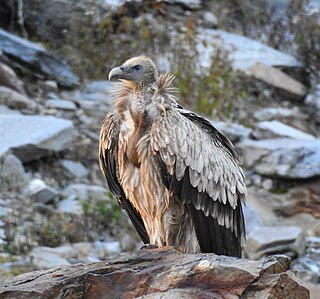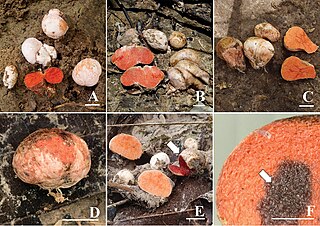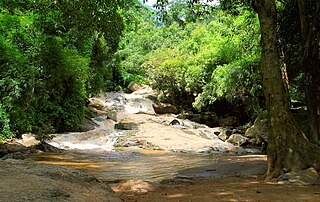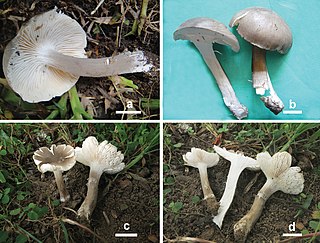Related Research Articles

The Himalayan vulture or Himalayan griffon vulture is an Old World vulture native to the Himalayas and the adjoining Tibetan Plateau. It is one of the two largest Old World vultures and true raptors. It is listed as Near Threatened on the IUCN Red List. It is not to be confused with the Eurasian griffon vulture, which is a similar and sympatric species.

The white-tailed nuthatch is a species of bird in the family Sittidae. It ranges across the northern and northeastern parts of the Indian Subcontinent, existing mainly in the low-to-middle Himalayas, as well as associated mountain ranges. It is found in Bhutan, India, Laos, Myanmar, Nepal, Tibet and Thailand.
Prunus arborea is a species of plant in the family Rosaceae. It is found in Indonesia, Malaysia, Singapore, and Thailand.
Muscodor is a genus of fungi in the family Xylariaceae noted for their ability to produce a variety of volatile organic compounds, which inhibit growth of other fungi. The first species to be identified was M. albus. Other known species include M. roseus and M. vitigenus.

Phlebopus is a genus of fungi in the family Boletinellaceae. The genus has a widespread distribution in subtropical and pantropical regions, and contains 12 species. The species are saprobic, with some possibly able to form mycorrhizae with exotic trees in certain conditions. It contains the gigantic Phlebopus marginatus, the cap of which can reach 1 m (3.3 ft) in diameter.

Amanita rubrovolvata, commonly known as the red volva amanita, is a species of fungus in the family Amanitaceae. The fungus produces small to medium-sized mushrooms, with reddish-orange caps up to 6.5 millimetres wide. The stems are up to 10 cm (4 in) tall, cream-coloured above the ring and cream to yellowish below it. The stem ends in a roughly spherical bulb at the base, which is covered with bright orange patches.
Mycoamaranthus is a genus of fungi in the family Boletaceae. The genus contains three species, found in Australasia, Africa, and Southeast Asia.

Rhodactina is a genus of secotioid fungi in the family Boletaceae. The genus was circumscribed in 1989 based on the type species Rhodactina himalayensis, found in India and northern Thailand. The genus was originally classified in the family Gauteriaceae because of similarities in spore ornamentation to the genera Gautieria and Austrogautieria. A second species, Rhodactina incarnata, was added to the genus in 2006. It is found in Dipterocarpaceae-dominated forests in Chiang Mai. Molecular phylogenetics analysis shows that Rhodactina is aligned with the Boletaceae.

Doi Suthep–Pui National Park is a national park in Chiang Mai Province in Thailand. It includes Wat Phra That Doi Suthep, a Buddhist temple, and Bhubing Palace, the winter residence of the Thai royal family. The park is a protected area for flora, fauna, and habitat.
Indraloris is a fossil primate from the Miocene of India and Pakistan in the family Sivaladapidae. Two species are now recognized: I. himalayensis from Haritalyangar, India and I. kamlialensis from the Pothohar Plateau, Pakistan. Other material from the Potwar Plateau may represent an additional, unnamed species. Body mass estimates range from about 2 kg (4.4 lb) for the smaller I. kamlialensis to over 4 kg (8.8 lb) for the larger I. himalayensis.
Micromonospora echinaurantiaca is an endophytic actinomycete.
Rhodactina incarnata is a species of secotioid fungus in the family Boletaceae. It is found in the sandy soil of dry, Dipterocarpaceae-dominated forests in Chiang Mai, northern Thailand. The fungus was described as new to science in 2006, becoming the second species in genus Rhodactina. The specific epithet incarnata, derived from the Latin for "flesh-colored," refers to the fruitbody color.
Protovis himalayensis is a prehistoric species of sheep found in latest Miocene to Late Pliocene-aged strata of Himalayan Tibet in 2016.

Cantharocybe virosa is a member of the fungal family Hygrophoraceae that has been identified in India, Bangladesh and Thailand. It is an ectomycorrhizal fungus that is toxic for consumption and has no know uses in agriculture, horticulture or medicine. C. virosa is a gray to gray-brown fungus with white to yellowish-white gills that can be found in soil or on mud walls near Cocos nucifera.
Streptomyces palmae is a bacterium species from the genus of Streptomyces which has been isolated from rhizosphere soil from the palm Elaeis guineensis in Chiang Mai in Thailand.

Coleroa is a genus of fungi belonging to the family Venturiaceae.
The Wickerhamomycetaceae are a family of yeasts in the order Saccharomycetales that reproduce by budding. Species in the family have a widespread distribution.
Fuscosporella is a genus of terrestrial and freshwater fungi in the family Fuscosporellaceae and within the monotypic order of Fuscosporellales.
References
- 1 2 Pegler DN, Young TW (1989). "Rhodactina himalayensis gen. et sp. nov. (Gauteriaceae) from India". Opera Botanica. 100: 201–206.
- ↑ Yang ZL, Trappe JM, Binder M, Sanmee R, Lumyong P, Lumyong S (2006). "The sequestrate genus Rhodactina (Boletales) in northern Thailand". Mycotaxon. 96: 133–140.